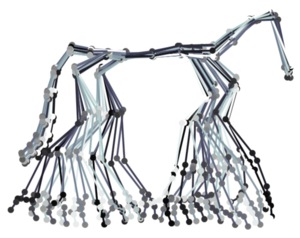Horse-Like Walking, Trotting, and Galloping derived from Kinematic Motion Primitives (kMPs) and their Application to Walk/Trot Transitions in a Compliant Quadruped Robot
2013
Article
dlg
This manuscript proposes a method to directly transfer the features of horse walking, trotting, and galloping to a quadruped robot, with the aim of creating a much more natural (horse-like) locomotion profile. A principal component analysis on horse joint trajectories shows that walk, trot, and gallop can be described by a set of four kinematic Motion Primitives (kMPs). These kMPs are used to generate valid, stable gaits that are tested on a compliant quadruped robot. Tests on the effects of gait frequency scaling as follows: results indicate a speed optimal walking frequency around 3.4 Hz, and an optimal trotting frequency around 4 Hz. Following, a criterion to synthesize gait transitions is proposed, and the walk/trot transitions are successfully tested on the robot. The performance of the robot when the transitions are scaled in frequency is evaluated by means of roll and pitch angle phase plots.
| Author(s): | Moro, Federico and Spröwitz, Alexander and Tuleu, Alexandre and Vespignani, M. and Tsagakiris, Nikos G. and Ijspeert, A. J. and Caldwell, Darwin G. |
| Journal: | Biological Cybernetics |
| Volume: | 107 |
| Number (issue): | 3 |
| Pages: | 309--320 |
| Year: | 2013 |
| Department(s): | Dynamic Locomotion |
| Bibtex Type: | Article (article) |
| DOI: | 10.1007/s00422-013-0551-9 |
|
BibTex @article{horse_2013,
title = {Horse-Like Walking, Trotting, and Galloping derived from Kinematic Motion Primitives (kMPs) and their Application to Walk/Trot Transitions in a Compliant Quadruped Robot},
author = {Moro, Federico and Spr{\"o}witz, Alexander and Tuleu, Alexandre and Vespignani, M. and Tsagakiris, Nikos G. and Ijspeert, A. J. and Caldwell, Darwin G.},
journal = {Biological Cybernetics},
volume = {107},
number = {3},
pages = {309--320},
year = {2013},
doi = {10.1007/s00422-013-0551-9}
}
|
|


